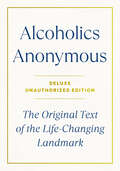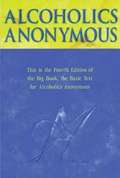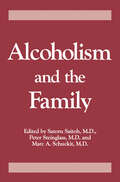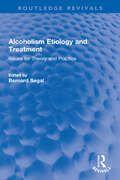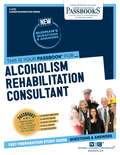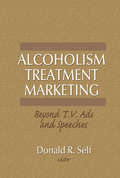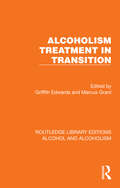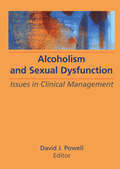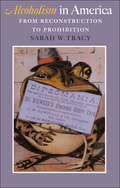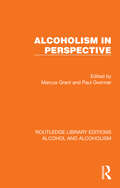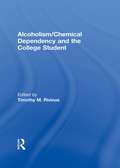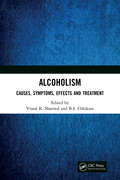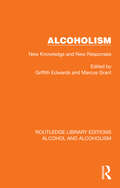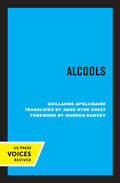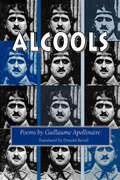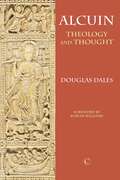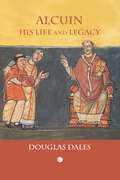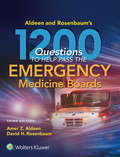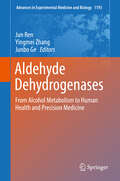- Table View
- List View
Alcoholics Anonymous: The Landmark of Recovery and Vital Living
by Mitch HorowitzThe self-help landmark that has led millions from addiction into revitalized lives is now faithfully condensed and introduced by PEN Award-winning historian Mitch Horowitz. Since its publication in 1939, Alcoholics Anonymous has brought a ray of light into the world, rescuing countless people the grinding compulsion of addiction and inspiring the global "twelve-step" movement. Now, historian and New Thought writer Mitch Horowitz provides a concise yet wholly faithful abridgement and introduction to the "Big Book," suited to newcomers who are first encountering its ideas, veterans looking for a refresher, and anyone curious about this classic of spiritual self-renewal. The genius of Alcoholics Anonymous is that its twelve-step program can be applied to any addiction or area of life where one is crippled by compulsion, whether gambling, drugs, debt-spending, chronic overeating, or whatever endangers your wellness and deters you from a life of vitality.
Alcoholics Anonymous: The Original 1939 Edition (Dover Empower Your Life)
by Bill W. Dick BAlcoholics Anonymous was founded in 1935 by Bill Wilson and Dr. Bob Smith, who developed the organization's twelve-step program. In 1939, they published this volume, which sets forth the cornerstone concepts of recovery and relates stories of those who have overcome alcoholism. Informally known as "The Big Book," it has gone through numerous editions, and as a lifeline to millions worldwide, it is the most widely used resource for recovering alcoholics. This edition features an Introduction by Dick B., an active recovered member of the Alcoholics Anonymous Fellowship.
Alcoholics Anonymous: The Original Text of the Life-Changing Landmark, Deluxe Edition
by Bill W.The most important and practical self-help book ever written, Alcoholics Anonymous. Here is a book that has changed millions of lives and launched the modern recovery movement: Alcoholics Anonymous.This edition not only reproduces the original 1939 text of Alcoholics Anonymous, but as a special bonus features the complete 1941 Saturday Evening Post article &“Alcoholics Anonymous&” by journalist Jack Alexander, which, at the time, did as much as the book itself to introduce millions of seekers to AA&’s program. Alcoholics Anonymous has touched and transformed myriad lives, and continues to change lives today.This book is not authorized or produced by, or otherwise affiliated with, Alcoholics Anonymous (A.A.W.S.) or its corporations, namely Alcoholics Anonymous World Services, Inc.
Alcoholics Anonymous: The Story Of How Many Thousands Of Men And Women Have Recovered From Alcoholism
by Alcoholics Anonymous World ServicesIt's more than a book. It's a way of life. Alcoholics Anonymous-The Big Book-has served as a lifeline to millions worldwide. First published in 1939, Alcoholics Anonymous sets forth cornerstone concepts of recovery from alcoholism and tells the stories of men and women who have overcome the disease. With publication of the second edition in 1955, the third edition in 1976, and now the fourth edition in 2001, the essential recovery text has remained unchanged while personal stories have been added to reflect the growing and diverse fellowship. The long-awaited fourth edition features 24 new personal stories of recovery. Key features and benefits +the most widely used resource for millions of individuals in recovery +contains full, original text describing A. A. the program +updated with 24 new personal stories.
Alcoholism And The Family
by Peter Steinglass Saturo Saitoh Marc A. SchuckitThe science of the etiology and treatment of alcohol has made notable progress in recent years. Since the early 1970s there have been growing in-roads made concerning the relevance of hereditary factors in alcoholism. This has led to the presentation of various innovative hypotheses in this field. In conjunction with this there has been much discussion and study of the "alcoholic personality" and its possible characteristics. These may be considered the "longitudinal aspects" linked to the transmission of alcoholism.
Alcoholism Etiology and Treatment: Issues for Theory and Practice (Routledge Revivals)
by Bernard SegalFirst published in 1988, Alcoholism Etiology and Treatment provides a stimulating discussion concerning an understanding of the etiology and treatment of alcoholism. Divided into five chapters, it brings themes like the disease concept of alcoholism; interdisciplinary biobehavioral research on alcohol problems; sociocultural and organizational bases of support for alcohol treatment; genetic predisposition to alcoholism; and anthropological perspectives on prevention and intervention, to provide a forum for discussion of some of the issues that prevail in the field of alcoholism. This book is an essential read for students and scholars of addiction studies, psychology, sociology, and behavioural studies.
Alcoholism Rehabilitation Consultant: Passbooks Study Guide (Career Examination Series #C-2772)
by National Learning CorporationThe Alcoholism Rehabilitation Consultant Passbook® prepares you for your test by allowing you to take practice exams in the subjects you need to study. It provides hundreds of questions and answers in the areas that will likely be covered on your upcoming exam, including but not limited to; Interviewing; Individual and group counseling; Preparing written material; Alcohol, alcoholism and related problems; and more.
Alcoholism Sourcebook
by Karen BellenirPresents a wealth of information on alcohol use and abuse and its effects on the body and mind, treatment, and prevention. Separate sections focus on use and abuse, physical effects, alcohol and pregnancy, alcohol and the brain, treatment and recovery, and prevention. A final section offers a glossary, a list of resources for people seeking help with recovery, a directory of general information resources, and a list of state substance abuse agencies. Material comes from publications issued by US government agencies, as well as organizations and professional journals. For general readers. Annotation c. Book News, Inc., Portland, OR (booknews.com)
Alcoholism Treatment Marketing: Beyond T.V. Ads and Speeches
by Donald SelfThe annual economic burden of alcohol abuse in the United States is staggering, yet the alcoholism treatment industry has been historically plagued by governmental regulations, moral crusades, advocacy of specific treatment approaches, and a lack of marketing knowledge. Here is the first focused set of research on the marketing of alcoholism treatment services. The authors of this much-needed volume--reputable marketing and research scholars--greatly expand the current base of knowledge concerning the alcohol treatment marketing subdiscipline, including the referral system analyses of market potentials for providers, promotional effort consultation for new providers, and the evolving nature of medical services distribution systems. Through in-depth interviews with treatment providers, referral sources, and former clients of treatment facilities, and in major reviews of literature on the subject, Alcoholism Treatment Marketing presents primary research and general research findings to provide practical marketing implications.
Alcoholism Treatment in Transition (Routledge Library Editions: Alcohol and Alcoholism)
by Griffith Edwards Marcus GrantOriginally published in 1980, the purpose of this book was to aid a process of rethinking alcoholism treatment. Such a process was already underway in many parts of the world at the time. It was hoped that this volume would be useful in the modest role of abetting such a rethinking. Alcoholism treatment was definitely in transition, abandoning old certainties, searching for new syntheses and that is the position this book takes looking for an alternative understanding. The book is divided into six parts: Transition as Challenge; Does Treatment Work?; Towards Better Questions and Better Methodologies; Treatment System as Case For Study; Models in Transition; and Alcohol Agendas. The book also contains one chapter that discusses alcoholism treatment in a developing country, not often addressed at the time but acknowledgement that the problem is a global one.
Alcoholism and Sexual Dysfunction: Issues in Clinical Management
by Bruce CarruthExperts provide specific methodologies for clinicians working with recovering alcoholics and their families. This landmark study of sexual issues in alcoholism treatment addresses impotence in male alcoholics, the sexual dynamics of the client-counselor relationship, homosexual alcoholics, and many other important issues.
Alcoholism in America: From Reconstruction to Prohibition
by Sarah W. TracyDespite the lack of medical consensus regarding alcoholism as a disease, many people readily accept the concept of addiction as a clinical as well as a social disorder. An alcoholic is a victim of social circumstance and genetic destiny. Although one might imagine that this dual approach is a reflection of today's enlightened and sympathetic society, historian Sarah Tracy discovers that efforts to medicalize alcoholism are anything but new.Alcoholism in America tells the story of physicians, politicians, court officials, and families struggling to address the danger of excessive alcohol consumption at the turn of the century. Beginning with the formation of the American Association for the Cure of Inebriates in 1870 and concluding with the enactment of Prohibition in 1920, this study examines the effect of the disease concept on individual drinkers and their families and friends, as well as the ongoing battle between policymakers and the professional medical community for jurisdiction over alcohol problems. Tracy captures the complexity of the political, professional, and social negotiations that have characterized the alcoholism field both yesterday and today.Tracy weaves American medical history, social history, and the sociology of knowledge into a narrative that probes the connections among reform movements, social welfare policy, the specialization of medicine, and the social construction of disease. Her insights will engage all those interested in America's historic and current battles with addiction.
Alcoholism in Perspective (Routledge Library Editions: Alcohol and Alcoholism)
by Marcus Grant Paul GwinnerIn the 1970s, an important change of emphasis had occurred in the field of alcoholism. Instead of seeing alcoholism as an ‘all or none phenomenon’ it was now recognised that a continuum of alcohol problems existed so that individual cases could show different degrees of dependence and different degrees of harm. Originally published in 1979, this book examines the implications of this change of emphasis. It looks at definitional, aetiological, epidemiological and socio-cultural questions and contains contributions from acknowledged experts in all of these areas. The scientific evidence in each area is fully reviewed and made comprehensible to the non-specialist reader and similarities between trends in thinking in different fields are emphasised. In addition, the book analyses the implications of the modern view of alcohol problems in terms of their theoretical basis and their practical application. A rational and pragmatic approach to the problems of working with alcoholics is analysed in some detail so that the links between new ideas and their manifestation in clinical practice are made clear. At the time, this book represented a multi-disciplinary approach to a complex problem where previous thinking had been clouded by too ready acceptance of untested hypotheses.
Alcoholism, Drug Addiction, and the Road to Recovery: Life on the Edge
by Barry StimmelGain a fuller understanding of substance addiction and treatment options!Originally published in 1992 as The Facts About Drug Use, this updated edition contains new information about the effects of alcohol and recreational, mood-altering drugs on the body. The multiple causes of drug use and the options available to those dependent on drugs as a way of life are thoroughly and clearly described. Drug use affects nearly 1 out of 2 Americans and cuts across every social and economic boundary. The effects of addiction on the individual are great, and the cumulative effects on society are staggering. Knowledge of the adverse effects of mood-altering drugs and why and how they are used excessively is a centerpiece of this book. It presents, intelligently and interestingly, ways to identify persons at risk and identify problems that the addicted encounter in attempts to become drug free. Alcoholism, Drug Addiction, and the Road to Recovery: Life on the Edge is an essential tool in both finding available resources for drug users and developing appropriate responses to today's drug problem.This remarkable, well-referenced book enables those with little or no background in science or health care to understand the complex issues surrounding drug use. It provides current, reliable, and unbiased information on methods for dealing with dependency upon alcohol and central nervous system depressants, hallucinogens, heroin, nicotine, marijuana, caffeine, amphetamines, designer drugs like Ecstasy, and steroids. A glossary listing common street names for drugs will be invaluable to those interested in identifying specific substances.This comprehensive volume will show you: who typically uses drugs and the reasons why they do how to classify mood-altering drugs how to identify and treat drug dependency areas of special concern such as multiple drug use, AIDS and drug use, drugs and pregnancy, drugs and sports, and drug testing technologyChapter by chapter, this nonjudgmental book helps readers develop a better understanding of the effects of mood-altering substances and the reasons many continue to use them despite serious consequences. This is a valuable key to the nature of dependency and addiction, and the external forces (including poverty and homelessness) that promote such behavior.
Alcoholism/Chemical Dependency and the College Student
by Leighton Whitaker Timothy RivinusProfessionals who work with college students--and college students themselves--address the current epidemic of drug use on college campuses in this timely book. In acknowledging that substance abuse problems proliferate during college and on into adult life when they then affect the next generation, the outstanding group of contributors offers forthright and clear descriptions, explanations, and suggestions for helping students, including examples of university services that have proven successful in dealing with student substance abuse. This helpful book aims to reverse the trend of ambivalence and confusion of administrators and college counselors regarding the area of substance use disorder by providing practical intervention strategies.
Alcoholism: Causes, Symptoms, Effects and Treatment
by Dr Vinod K. Shanwal And Dr. B. S. ChhikaraThe book includes research on multi-dimensional aspects of problems related to alcohol. The chapters cover a wide range of topics on the theme of Alcoholism ranging from reasons and factors that induce alcoholism, to health risks and finally possible medical, psychological and alternative remedial measures. Various factors such as genetics, childhood influences, antisocial behavior, and personality traits contribute to this menace of alcoholism. Cultural values, beliefs, and childhood experiences to govern thought process are indirectly related to earlier stages of alcohol addiction. Family history and life stress have implications on individual/s susceptibility to alcohol addiction. Personality traits influence the addiction in individuals. The treatment of alcoholism involves different therapies besides medicines for comprehensive and smooth recovery of the person. The important inducing factors, impact on society, individual, brain, family, nutritional deficiency and possible therapies such as body psychotherapies, herbal and natural therapy have been covered in the book in hopes of a comprehensive solution.Note: T& F does not sell or distribute the Hardback in India, Pakistan, Nepal, Bhutan, Bangladesh and Sri Lanka.
Alcoholism: New Knowledge and New Responses (Routledge Library Editions: Alcohol and Alcoholism)
by Griffith Edwards Marcus GrantOriginally published in 1977, alcoholism was acknowledged to be a seriously growing problem in many parts of the world. It is a complex disorder with psychiatric, physical, psychological and social aspects, having far reaching harmful effects on the family and society, as well as on physical and mental health of the alcoholic themself. At the time of original publication it had been estimated that in England and Wales 11 out of every 1,000 in the adult population had a serious drink problem, and alcoholism was a major cause of admission to psychiatric and general hospitals. Alcoholism was a medico-social problem of such magnitude that this comprehensive volume, embodying advances in knowledge of causation, treatment and prevention filled an urgent need at the time. Still a major concern today this reissue can be read in its historical context.
Alcools
by Guillaume ApollinaireThis title is part of UC Press's Voices Revived program, which commemorates University of California Press’s mission to seek out and cultivate the brightest minds and give them voice, reach, and impact. Drawing on a backlist dating to 1893, Voices Revived makes high-quality, peer-reviewed scholarship accessible once again using print-on-demand technology. This title was originally published in 1965.
Alcools: Poems (Wesleyan Poetry Series)
by Guillaume ApollinaireA new translation of this complex and beautiful poetry.Alcools, first published in 1913 and one of the few indispensable books of twentieth-century poetry, provides a key to the century's history and consciousness. Champion of &“cubism&”, Guillaume Apollinaire (1880-1918) fashions in verse the sonic equivalent of what Picasso accomplishes in his cubist works: simultaneity. Apollinaire has been so influential that without him there would have been no New York School of poetry and no Beat Movement. This new translation reveals his complex, beautiful, and wholly contemporary poetry. Printed with the original French on facing pages, this is the only version of this seminal work of French Modernism currently available in the United States.
Alcott Hall (Second Sons)
by Emily RathA spicy, smart, standalone &“Why Choose&” Regency romance set three years after the events of the Second Sons duology from New York Times bestselling author Emily Rath.The Lady has an offer. The Vicar has a confession. The Game Warden has a secret. When her late aunt leaves her a generous fortune, socially awkward Lady Madeline Blaire believes she&’s finally found a way out of the high society husband hunt. There&’s only one problem. To claim it, Madeline must marry by New Year&’s Eve . . . which is now only 3 weeks away! Determined to claim her financial freedom, Madeline slips away from her overbearing family and races off to Alcott Hall. Madeline needs a husband. Now. She&’ll be generous, providing him with a comfortable living. She doesn&’t even care if he takes other lovers. All he must do is agree never to claim his rights as her husband. 3 years ago, vicar Charles Bray left the town of Finchley and never looked back. When duty calls him home, he returns heavy hearted, desperate to avoid one man—John Warren, game warden of Alcott Hall. As Charles does his best to evade Warren&’s snare, he starts an unlikely friendship with Lady Madeline, who soon makes him an offer too good to refuse. Charles and Madeline could have everything they want . . . if only Warren will stay out of way. But Warren holds a secret that could up-end all their careful plans. Does Madeline want a comfortable life married to a kind vicar? Or will she dare to risk it all on the penniless warden? Perhaps there&’s a third option none of them dreamed possible. An option where no one has to choose . . .
Alcuin II: Theology and Thought
by Douglas DalesScholar, ecclesiastic, teacher and poet of the eighth century, Alcuin can be seen as a true hidden saint of the Church, of the same stature and significance as his predecessor Bede. His love of God and his grasp of Christian theology were rendered original in their creative impact by his gifts as a teacher and poet. In his hands, the very traditional theology that he inherited, and to which he felt bound, took new wings. In that respect, he must rank as one of the most notable and influential of Anglo-Saxon Christians, uniting English and continental Christianity in a unique manner, which left a lasting legacy within the Catholic Church of Western Europe. This book is intended for the general reader as well as for those studying, teaching or researching this period of early medieval history and theology in schools and universities.
Alcuin: His Life and Legacy
by Douglas DalesScholar, ecclesiastic, teacher and poet of the eighth century, Alcuin was a person of deep Christian faith, tenacious in his loyalty to orthodox Catholic theology. He had a seminal influence upon his own generation and those that came after him. Althoughhe remained a Northumbrian Christian at heart, the part of his life about which most is known was spent on the Continent. He never lost contact with his homeland; but his most significant and lasting work was evidently accomplished in Europe and his influence on the early medieval Western Church was an abiding one. This book examines his life and career in England and on the continent; it also considers his legacy as a churchman and a leading political figure. This volume prefigures a forthcoming work onAlcuin's intellectual legacy, 'Alcuin : A Study of his Theology' (due for release, April 2013). This rich study is intended for the general reader as well as for those studying, teaching or researching this period of early medieval history and theology in schools and universities.
Aldabra, or the Tortoise Who Loved Shakespeare
by Silvana Gandolfi"The way to outsmart death, Elisa dear, is to turn into something else!" It's just one of those things Elisa's dramatic grandmother says. She loves Shakespeare. She paints bold canvases in her backyard. She's always had a magical personality. But when Nonna talks about turning into something else, does she mean it... literally? Faced with an ever-more tortoise-like grandmother, Elisa must uncover a series of mysteries: Why is it that her mother and her grandmother don't talk? Where is the exotic island of Aldabra--and why does Nonna want to go there? Who is the man on the Internet so eager to know the details of Nonna's transformation? And where can Elisa turn to for help? Suspenseful, funny, and beautifully observed, Aldabra takes readers from the sparkling canals of Venice to the islands of the Indian Ocean, and beyond...!
Aldeen and Rosenbaum's 1200 Questions to Help You Pass the Emergency Medicine Boards
by Amer Aldeen David H. RosenbaumFully revised and updated based on valuable reader feedback, Aldeen and Rosenbaum's 1200 Questions to Help You Pass the Emergency Medicine Boards, Third Edition gives you the tools you need to pass the ABEM board exam on the first try. Questions are slightly more difficult than the average exam question, in order to challenge and add to your knowledge and fully prepare you for questions you’re likely to see. Every question in this Third Edition has been reviewed for quality and relevance, ensuring that this unique study tool is an ideal choice to prepare for both the in-service residency exam and the board exam in emergency medicine.
Aldehyde Dehydrogenases: From Alcohol Metabolism to Human Health and Precision Medicine (Advances in Experimental Medicine and Biology #1193)
by Jun Ren Yingmei Zhang Junbo GeThis volume covers the science of ALDH enzymes in relation to chronic disease processes and the future therapeutic potentials of targeting ALDH in these processes. It thoroughly reviews the roles of ALDH family in alcohol metabolism, as well as recent findings of their emerging roles in a variety of human pathologies such as cardiovascular diseases, diabetes, obesity, stroke, cancer, liver diseases and kidney diseases. Delicate contribution of ALDH enzymes in the therapeutics against chronic diseases is also discussed. It demonstrates the unique value of targeting genetic polymorphism in ALDH enzymes in personalized medicine. The book will appeal to scientists, physicians, graduate and professional students in the fields of ALDH enzymes, alcohol metabolism, cardiometabolic and other chronic diseases. Pharmaceutical and other companies developing new tools for cardiometabolic and chronic diseases treatment will also find this a valuable resource.


